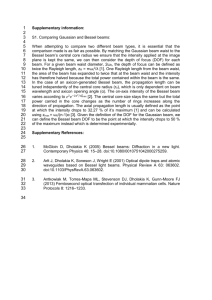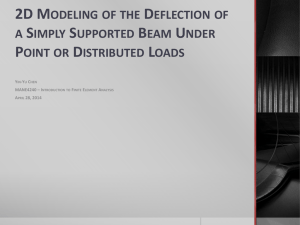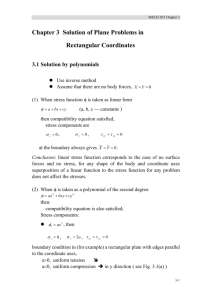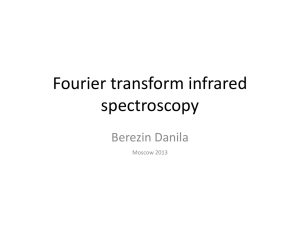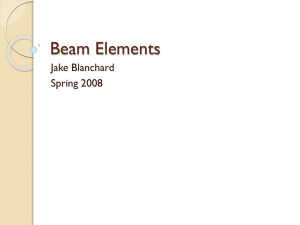Finite Element Method
advertisement
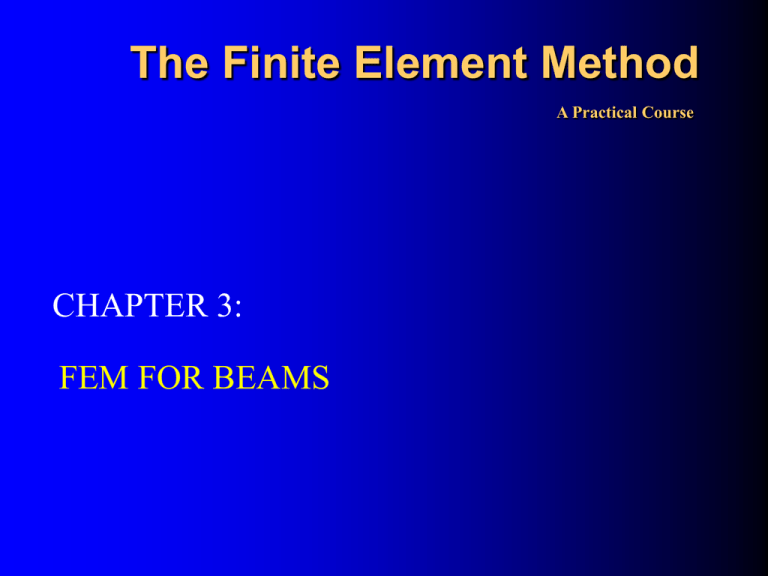
The Finite Element Method A Practical Course CHAPTER 3: FEM FOR BEAMS CONTENTS INTRODUCTION FEM EQUATIONS – Shape functions construction – Strain matrix – Element matrices – Remarks EXAMPLE AND CASE STUDY – Remarks INTRODUCTION The element developed is often known as a beam element. A beam element is a straight bar of an arbitrary cross-section. Beams are subjected to transverse forces and moments. Deform only in the directions perpendicular to its axis of the beam. INTRODUCTION In beam structures, the beams are joined together by welding (not by pins or hinges). Uniform cross-section is assumed. FE matrices for beams with varying cross-sectional area can also be developed without difficulty. FEM EQUATIONS Shape functions construction Strain matrix Element matrices Shape functions construction Consider a beam element d1 = v1 d3 = v2 d4 = 2 d2 = 1 x, 0 2a x= - a x= a = 1 =1 x Natural coordinate system: a Shape functions construction Assume that v( ) 0 1 2 3 In matrix form: v( ) 1 2 2 0 3 1 2 3 or 3 v( ) p T ( )α v v 1 v 1 (1 2 2 3 3 2 ) x x a a Shape functions construction d1 = v1 d3 = v2 d4 = 2 d2 = 1 x, 0 2a x= - a x= a = 1 =1 To obtain constant coefficients – four conditions (1) v(1) v1 (2) dv 1 dx 1 (3) v(1) v2 (4) dv 2 dx 1 At x= a or = 1 At x= a or = 1 Shape functions construction v1 1 1 0 1 1 a v2 1 1 2 0 1a 1 2 a 1 2 a 1 1 3 a 2 or d e A eα 1 3 3 a 4 a 2 a 2 3 a 3 a 1 A e1 a 4 0 a 0 a 1 a 1 or α A e1d e Shape functions construction Therefore, v N( )d e where N( ) PA e1 N1 ( ) N 2 ( ) N 3 ( ) N 4 ( ) in which N1 ( ) 14 (2 3 3 ) N 2 ( ) a4 (1 2 3 ) N 3 ( ) 14 (2 3 3 ) N 4 ( ) a4 (1 2 3 ) Strain matrix u 2v xx y yLv 2 x x Eq. (2-47) Therefore, 2 y 2 y B yLN y 2 N 2 N N 2 2 x a a where N N1 N 2 3 a N1 , N 2 (1 3 ) 2 2 3 a N 3 , N 4 (1 3 ) 2 2 N 3 N 4 (Second derivative of shape functions) Element matrices k e B cBdV E y dA T 2 a a V A 1 EI z 1 EI k e 3z a 1 1 2 2 T ( 2 N) ( 2 N)dx x x 2 EI z 1 2 T [ 2 N] [ 2 N]ad 3 4 a a N1N1 N N 2 1 N3N1 N 4N1 N1N 2 N1N3 N 2N 2 N 2N 3 N3N 2 N3N3 N 4N 2 N 4N 3 Evaluate integrals 1 1 N T N d N1N 4 N 2N 4 d N 3N 4 N 4N 4 3 3a 4a 2 EI z ke 3 2a sy. 3 3a 3a 2a 2 3 3a 4a 2 Element matrices m e N NdV dA T a a V N Ndx A T 1 1 NT Nad A Aa 1 1 N1 N1 N N 2 1 N 3 N1 N 4 N1 N1 N 2 N1 N 3 N2 N2 N3 N 2 N4 N2 N 2 N3 N3 N3 N 4 N3 Evaluate integrals N1 N 4 N 2 N 4 d N3 N 4 N 4 N 4 78 22a 27 13a 8a 2 13a 6a 2 Aa me 78 22a 105 2 sy . 8 a Element matrices f s1 f y a f s1 N1 f y a2 1 N2 ms1 3 ms1 T T fe N fb dV N f s dS f f y a d 1 N f a f f s2 3 V Sf s2 y f y a2 m N 4 s 2 3 ms 2 f k ede med e e Remarks Theoretically, coordinate transformation can also be used to transform the beam element matrices from the local coordinate system to the global coordinate system. The transformation is necessary only if there is more than one beam element in the beam structure, and of which there are at least two beam elements of different orientations. A beam structure with at least two beam elements of different orientations is termed a frame or framework. EXAMPLE Consider the cantilever beam as shown in the figure. The beam is fixed at one end and it has a uniform cross-sectional area as shown. The beam undergoes static deflection by a downward load of P=1000N applied at the free end. The dimensions and properties of the beam are shown in the figure. P=1000 N 0.1 m E=69 GPa =0.33 0.5 m 0.06 m EXAMPLE Exact solution: 4v EI y 4 f y 0 x fy 0 Eq. (2.59) Step 1: Element matrices 1 3 1 3 I z bh 0.1 0.06 1.8 106 m 4 12 12 69 10 1.8 10 9 K ke 6 2 0.253 0.75 3 0.75 0.25 3.974 106 3 0.75 0.75 0.125 0.75 3 0.75 3 0.75 0.25 0.75 0.125 3 0.75 3 0.75 0.75 0.125 0.75 0.25 3 0.75 0.75 0.125 Nm -2 3 0.75 0.75 0.25 Px 2 v( x) (3L x) 6 EI y PL3 v( x L) 3EI y = -3.355E10-4 m P=1000 N E=69 GPa =0.33 0.5 m P=1000 N EXAMPLE v1 1 0 E=69 GPa Step 1 (Cont’d): =0.33 0.5 m 0.75 3 0.75 v1 Q1 ? unknown reaction shear force 3 0.25 0.75 0.125 1 M 1 ? unknown reaction moment 6 0.75 3.974 10 3 0.75 3 0.75 v2 Q2 P 0.75 0.125 0.75 0.25 2 M 2 0 D K F Step 2: Boundary conditions v1 1 0 0.75 3 0.75 v1 0 Q1 3 0.75 0.25 0.75 0.125 0 M 1 1 3.974 106 3 0.75 3 0.75 v2 Q2 P 0.75 0.125 0.75 0.25 2 M 2 0 EXAMPLE Step 2 (Cont’d): 0.75 3 -2 K 3.974 10 Nm 0.75 0.25 6 Therefore, K d = F, dT where 1000 = [ v2 2] , F 0 Step 3: Solving FE equation (Two simultaneous equations) v2 = -3.355 x 10-4 m 2 = -1.007 x 10-3 rad EXAMPLE 0.75 3 0.75 v1 Q1 ? 3 0.25 0.75 0.125 1 M 1 ? 6 0.75 3.974 10 3 0.75 3 0.75 v2 Q2 P 0.75 0.125 0.75 0.25 2 M 2 0 D K F Step 4: Stress recovering v2 = -3.355 x 10-4 m 2 = -1.007 x 10-3 rad Q1 3.974 106 (3v2 0.75 2 ) 3.974 106 [3 (3.355 104 ) 0.75 (1.007 103 )] 998.47N M 1 3.974 106 (0.75v2 0.125 2 ) 3.974 106 [0.75 (3.355 104 ) 0.125 (1.007 103 )] 499.73Nm Substitute back into first two equations Remarks FE solution is the same as analytical solution Analytical solution to beam is third order polynomial (same as shape functions used) Reproduction property CASE STUDY Resonant frequencies of micro resonant transducer Bridge Membrane CASE STUDY Natural Frequency (Hz) Number of 2node beam elements Mode 1 Mode 2 Mode 3 10 4.4058 x 105 1.2148 x 106 2.3832 x 106 20 4.4057 x 105 1.2145 x 106 2.3809 x 106 40 4.4056 x 105 1.2144 x 106 2.3808 x 106 60 4.4056 x 105 1.2144 x 106 2.3808 x 106 Analytical Calculations 4.4051 x 105 1.2143 x 106 2.3805 x 106 [ K lM ]f = 0 Section 3.6, pg. 58 CASE STUDY Mode 1 (0.44 MHz) 1.2 Dy (um) 1 0.8 0.6 0.4 0.2 0 0 20 40 60 x (um) 80 100 CASE STUDY Mode 2 (1.21MHz) 1.5 Dy (um) 1 0.5 0 -0.5 0 20 40 60 -1 -1.5 x (um) 80 100 CASE STUDY Mode 3 (2.38 MHz) 1.5 Dy (um) 1 0.5 0 -0.5 0 20 40 60 -1 -1.5 x (um) 80 100



